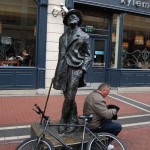Dublin, the capital of Ireland
DUBLIN is the capital of the republic of Ireland, a state located in Western Europe and occupying the biggest part of the island of Ireland. The population of the city is 478 thousand people (together with suburbs – 911 thousand people).
The earliest mention about Dublin can be found on Ptolemy’s map drawn in 140 A.D. A settlement called Eblana is shown on this place. In 837 a Norman flotilla consisting of 60 ships arrived in this area. Four years later, in 841 the Normans founded a city of Dublin there. Scandinavian name of the city means “black pool”; Irish one – “town of the hurdled ford.” The city was the administrative center of Norman lands in Ireland and the main connection point with Scandinavia. From XII century an English invasion into Ireland began. In 1215 by an order of the king of England a castle was built in Dublin that signified English authority in Ireland. The Irish many times rebelled against the colonizers. The biggest rebellions took place in 1534, 1641 and 1646. Struggle for freedom increased in XVIII-XIX centuries. As a result of a national movement for liberation in 1921 the English government was forced to give the Southern Ireland a status of a Dominion. Dublin became the capitol of Eire – a free Irish state. Since 1949 Dublin is the capitol of the Republic of Ireland. Here the president’s residence, the parliament and government offices are located.
Dublin is situated in an amazingly beautiful bay. Two channels – Royal and Grand – as well as the Liffey River that flows into Dublin Bay run through it. Dry cargo ships with timber and coal as well as tankers with mineral oil come to Dublin’s port. Arrows of lifting cranes are rising on the shore of the bay.
In the vicinity of the port there’s one of the noteworthy constructions of Dublin – the old customs built in XVIII century crowned with the National Emblem and allegoric figures signifying Atlantic Ocean and the biggest rivers of Ireland.
Between the port and the city O’Connell’s bridge is constructed; its breadth surpasses its length. Penny Bridge bears its name because in old times crossing it cost a penny.
The oldest of all the architectural monuments of Dublin that remained are Christ Church Cathedral dating back to 1038, decorated inside with fine stone carving, azure vaults and colonnades, and St. Patrick’s Cathedral built in 1190 by the first English archbishop of Dublin. The latter is a big construction of gray granite in Norman style with a high spire. The Cathedral is famous for Jonathan Swift, the author of “Gulliver’s Travels”, being its dean for 32 years – from 1713 till 1745. The pulpit from which Swift read his sermons is kept with care in the cathedral. The cathedral was built in honor of St. Patrick who baptized Ireland in V century A.D. St. Patrick died on March 17, 461. The Day of St. Patrick became a day of unity of all the Irish living in different parts of the world. On this day the streets of Dublin turn into a colorful carnival procession called “St. Patrick’s Parade.” Orchestras of bagpipers dressed in checkered kilts are marching, columns of children are walking by and impetuous dancers in embroidered national dresses are standing in circles.
In the center of the city the Parliament, the Court and National Art Gallery are located. The building of Irish Parliament – Leinster House – is semicircular, surrounded by a balustrade in a form of Ionic columns of Corinthian order. It is believed that Leinster House was an archetype of the White House in Washington.
The monumental building of the Four Courts is framed by statues of Justice, Wisdom, Mercy and Authority.
The building of the main post office is in a form of an ancient Greek temple with porticos and Ionic columns and is decorated with allegoric sculptures.
Pages: 1 2

